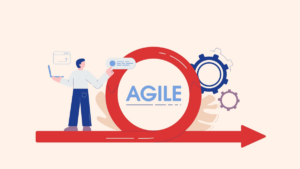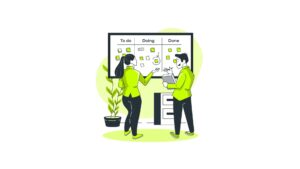Accept Cookies & Privacy Policy?
We use cookies to ensure that we give you the best experience on our website. If you continue to use this site we will assume that you accept and understand our Privacy Policy, and our Terms of Service.
I’ve been in the Agile trenches for years now—coaching teams, facilitating sprints, navigating the choppy waters of transformations that promised the moon but barely delivered a sprint review. If there’s one thing I’ve learned, it’s that Agile is like water—it evolves, it adapts, and sometimes, it drowns you if you’re not prepared.
So, what’s next for Agile as we step into the future beyond 2025? Here’s my take—straight from the Scrum Master’s playbook, no fluff, no jargon.
Artificial Intelligence isn’t coming for your stand-ups (yet), but it’s definitely reshaping Agile. AI-driven analytics, automated retros, and predictive sprint planning will become the norm. Tools will recommend backlog priorities based on data patterns, and bots will handle the tedious admin work. Does that mean Scrum Masters are out of a job? Nope. It means we’ll shift from facilitators to enablers—coaching teams to use AI insights effectively rather than just running ceremonies.
We’ve talked about Agile expanding beyond software for years. Now, it’s happening at scale. Marketing, HR, legal, even construction—everyone’s adopting Agile in some form. The challenge? Most of them are doing it wrong. The future Scrum Master’s role will be to guide these non-tech teams without overwhelming them with Jira boards and burndown charts they don’t need.
AI and automation are no longer just futuristic buzzwords—they’re becoming Agile’s biggest disruptors. Imagine AI-driven backlog grooming, automated sprint planning based on team performance data, and even intelligent retrospectives that highlight recurring patterns.
Here’s what AI in Agile might look like:
AI-Powered Agile Coaches – Virtual assistants that analyze team performance, suggest improvements, and even identify blockers before they become issues.
Automated Stand-ups – AI bots that gather real-time updates from team members and summarize key takeaways, reducing unnecessary meetings.
Predictive Sprint Planning – Algorithms that analyze past sprint velocity and recommend optimal workloads, helping teams balance ambition with realism.
is it the end of the game?
No, not at all. Our role will shift from manual facilitation to AI-enabled decision-making. Instead of spending hours analyzing team data, we’ll use AI insights to drive meaningful conversations. But here’s the catch although AI can optimize processes, but it can’t replace the human element of Agile. Emotional intelligence, team motivation, and conflict resolution? Those are still very much ours to handle.
AI-Powered Agile Coaches – Virtual assistants that analyze team performance, suggest improvements, and even identify blockers before they become issues.
Automated Stand-ups – AI bots that gather real-time updates from team members and summarize key takeaways, reducing unnecessary meetings.
Predictive Sprint Planning – Algorithms that analyze past sprint velocity and recommend optimal workloads, helping teams balance ambition with realism.
No, not at all. Our role will shift from manual facilitation to AI-enabled decision-making. Instead of spending hours analyzing team data, we’ll use AI insights to drive meaningful conversations. But here’s the catch although AI can optimize processes, but it can’t replace the human element of Agile. Emotional intelligence, team motivation, and conflict resolution? Those are still very much ours to handle.
Let’s be honest—Agile has become a framework frenzy. SAFe, LeSS, Disciplined Agile—each promising agility but often adding complexity. Companies will start realizing that agility isn’t about following a framework to the letter but about picking what works. As a Scrum Master, my job will be less about enforcing Scrum Guide rules and more about helping teams build Agile muscle memory.
Hybrid work is here to stay, and Agile hasn’t fully caught up. Remote daily stand-ups often feel like passive Zoom calls, and retros get lost in Slack threads. Future Agile teams will need better ways to foster collaboration—think virtual whiteboards, async sprint planning, and AI-assisted retrospectives that capture real-time sentiment. The Scrum Master’s challenge? Keeping the human element alive in a world where cameras are always off.
Velocity, story points, and sprint burndowns are great—until they’re not. Leaders are waking up to the fact that delivering 100 story points a sprint means nothing if it’s not driving business value. Future Agile teams will shift towards impact-driven metrics. Expect KPIs around customer satisfaction, user adoption, and revenue influence rather than just “how many tickets got done.” Scrum Masters will be the bridge, helping teams connect their work to real business outcomes.
Remember when Scrum Masters were “just facilitators”? Then we became Agile coaches, transformation leads, and part-time therapists. In the coming years, expect the role to evolve further. We’ll need to be data-savvy, AI-literate, and business-aware. The best Scrum Masters won’t just run retros—they’ll be guiding leadership on agility at scale.
Agile isn’t going anywhere. But it is changing. The future isn’t about blindly following the Agile Manifesto but about embracing agility as a mindset. Scrum Masters will be less about enforcing frameworks and more about enabling adaptability.
So, what’s the future of Agile beyond 2025? In one word—evolution. And as a Scrum Master, my job is to help my teams not just survive but thrive in it.
Let’s talk Agile!

I’ve been in the Agile trenches for years now—coaching teams, facilitating sprints, navigating the choppy waters of transformations that promised the moon but barely delivered a sprint review. If there’s one thing I’ve learned, it’s that Agile is like water—it evolves, it adapts, and sometimes, it drowns you if you’re not prepared.

So picture this: You’re the air traffic controller of a chaotic airport where the planes (developers) don’t always listen, the passengers (stakeholders) want to change destinations mid-flight, and the weather (unforeseen blockers) is always unpredictable.

Imagine a world where testing is no longer a bottleneck. No more endless cycles of manual effort, no more missed defects due to human fatigue, and no more panic at the eleventh hour before a major ERP rollout.

Imagine a world where testing is no longer a bottleneck. No more endless cycles of manual effort, no more missed defects due to human fatigue, and no more panic at the eleventh hour before a major ERP rollout.

Let’s talk about GenAI and testing in 2025—the wild west of technology where machines are not just smart, but scary smart. GenAI (that’s Generative AI for the uninitiated) is running the show everywhere. It’s writing poetry, designing ads, debugging code, and probably plotting to take over my job as I write this blog.

Ah, 2024—you’ve been a year, haven’t you? For us at Thought Frameworks, this year wasn’t just about running the usual QA/QE playbook. Nope, we went full throttle into the future—tinkering, testing, and transforming everything from ERP systems to the ever-evolving world of SAP, GenAI, and security testing.
If you’ve been in the software world for even a minute, you know testing isn’t just a thing—it’s THE thing. Bad testing = broken apps, angry users, and lost revenue. And let’s be real, in 2025, with AI running wild, apps launching every second, and users having zero patience for bugs, testing has to be next-level.
Accept Cookies & Privacy Policy?
We use cookies to ensure that we give you the best experience on our website. If you continue to use this site we will assume that you accept and understand our Privacy Policy, and our Terms of Service.
| Cookie | Duration | Description |
|---|---|---|
| cookielawinfo-checkbox-analytics | 11 months | This cookie is set by GDPR Cookie Consent plugin. The cookie is used to store the user consent for the cookies in the category "Analytics". |
| cookielawinfo-checkbox-functional | 11 months | The cookie is set by GDPR cookie consent to record the user consent for the cookies in the category "Functional". |
| cookielawinfo-checkbox-necessary | 11 months | This cookie is set by GDPR Cookie Consent plugin. The cookies is used to store the user consent for the cookies in the category "Necessary". |
| cookielawinfo-checkbox-others | 11 months | This cookie is set by GDPR Cookie Consent plugin. The cookie is used to store the user consent for the cookies in the category "Other. |
| cookielawinfo-checkbox-performance | 11 months | This cookie is set by GDPR Cookie Consent plugin. The cookie is used to store the user consent for the cookies in the category "Performance". |
| viewed_cookie_policy | 11 months | The cookie is set by the GDPR Cookie Consent plugin and is used to store whether or not user has consented to the use of cookies. It does not store any personal data. |
Ready for a Quality Software?
Let’s Dig Deep Into Your Thought!